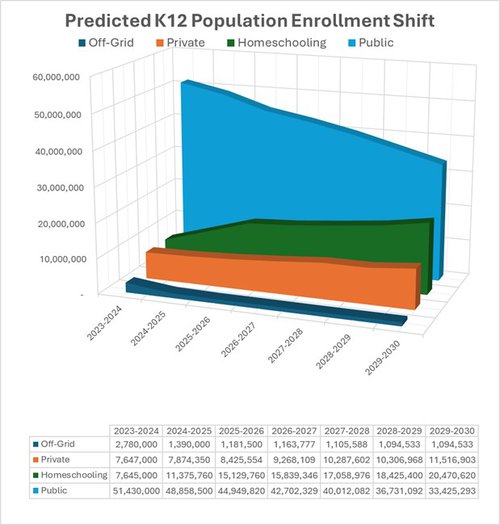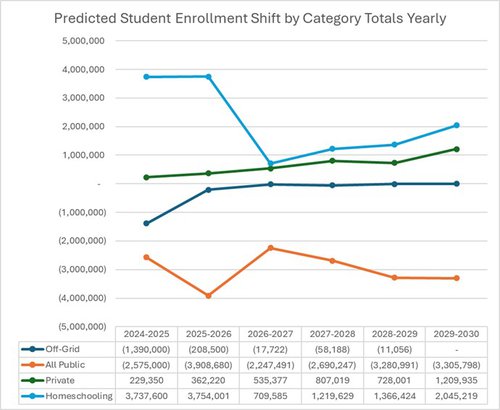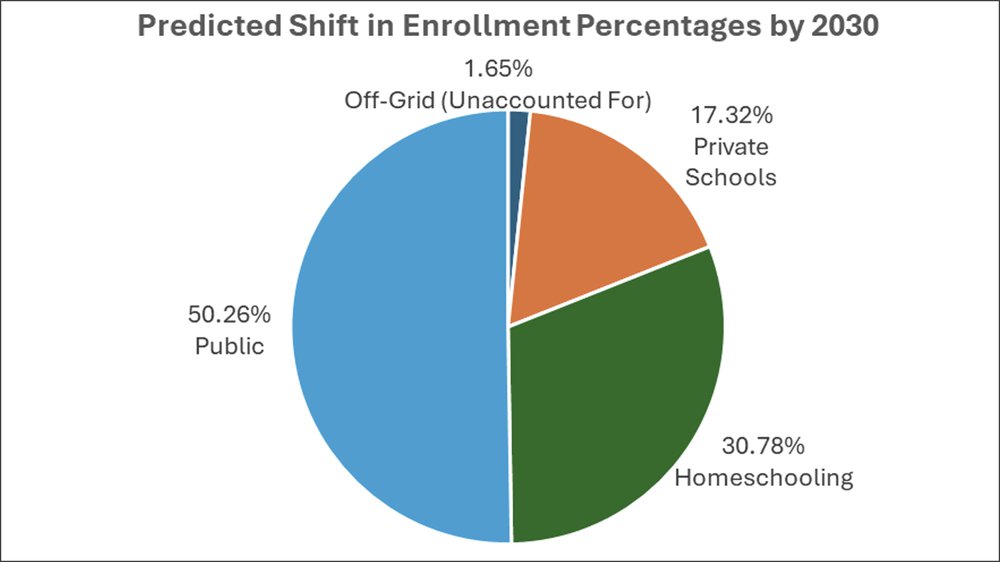Thousands of data points go into how models can be built to make any sort of prediction. Learning Counsel, as a media and research organization, has a ten-year history of predicting how the threads of change will impact the education market with great success.
Today’s biggest threads have to do with absenteeism, teacher shortage, rising voucher legislation, and culture change. These and more point to significant shifts in the landscape and structures of K12 education by 2030.
Already some public schools are being forced to share teachers with remote schools in their own or other districts due to epic shortages, even while attrition to alternatives continues and homeschooling has been rising by 65% every year, only moderately down from the 85% growth during the pandemic years but expected to wane significantly in growth rate.
Another thing to note as a thread in modeling for America is that teachers Unions and many policies in schools have come down squarely on only one side of the political scene for years, and only in recent months has America been seeing State Governor’s issuing surprising counter moves, largely in the Midwest and South.
Meanwhile there are the peculiarities of the Alpha Generation to consider with their immersion into screens, the economy, massive out-migration from cities, outside industry trends causing consumer demand for highly flexible and personalized arrangements in all things, plus technology innovations promising to change the entirety of education workflow and the organization of institutions through a myriad of AI and mechanisms. Policies and lobbying to avert the outcomes were considered in the predictions as highly likely to fail with the principal driver simple economics. State and local governments cause massive savings for themselves in the act of privatizing K12 education, saving upwards of 70% or more on all costs while retaining the same income from taxation. That is billions of dollars for most States annually that is becoming increasingly difficult to argue against as traditional public schools continue to fail in their mission of educating the American public as seen on abysmal literacy and math scores from so much of the population. Negative sentiment has reached a fevered pitch.
The importance of showing trend convergence and helping administrators understand how to navigate and potentially survive it all in some new incarnation can’t be understated.
Trends tend to accelerate when they reach a certain critical mass – and that tipping point is due to arrive well within the next three years.

By 2030 purely public schooling is predicted to be at or just above 50% of the market, probably thereafter accelerating to a far more privatized-but-regulated industry much like what has already happened with most of the energy industry and hospitals that were once public works, and examples like the State of Washington’s privatization of alcohol sales in 2012 – but education continuing to be subsidized by vouchers in a similar construct to other government programs such as Medicaid.
The net loss to public education (traditional schools, charters, public online virtuals) is estimated at just over 16 million students in the next six years. This loss is despite massive new enrollments of new immigrants, and will be cataclysmic for traditional schools, politics, and the vendors that rely on sales to this sector. Some of this loss is due to lower birth rates. By far the majority of loss will be due to inflexibility in both schedule and inability to be remote.
With so many States adopting Choice legislation and issuing vouchers, the biggest shift year is expected to be 2025-2026 as awareness expands amongst more parents and students.
By the end of 2030 the prediction is that there will be an average of between 2,400 and 4,700 students per district in lower enrollments starting with the mid-tier in size (which has had an average of 7,500 students) on up to the largest of course having a bigger difference. That overall loss includes taking into consideration the now nominal gain of new enrollments from mass immigration which had a huge wave in 2023-2024 but is tapering off and expected to go down.

Learning Counsel predicts districts will go through several rounds of consolidations before attempting a more learning-consumer restructure including retail-like-outlet study centers dotting neighborhoods to satisfy demands of nearness rather than the trend in consolidation that makes schools more distant and aggregated. In order to do this, schools will need to lean increasingly on technologies and new logistics to manage teacher intersection in a in a flexible array across networks geographically. Some teachers on-site, many remote in a sharing construct.
The biggest gains will be in homeschooling, but with a rather loose definition because a lot of curriculum guidance and tutoring intercession may be augmented by technologies that may even tie back to public governance or private purely online curriculum constructs that are not “schools” but provide considerable help. Additionally, big gains in private schools with so many more States passing vouchers. Existing private school students are only the first wave, and the trend will continue and then taper within five years. A significant portion of private schooling will be purely online, challenging the demarcation between what is homeschooling and what is considered regular schooling. New policies are expected to be implemented that tie conditions on public funds used in private schooling. None of the sector numbers, therefore, are absolute in definition because of the shift in technologies supporting remote education, policy and funding changes.
The biggest drivers away from publicly administered education are, in this order:
- Choice legislation,
- Remote preference, which is driving a lot of the absenteeism, alternative enrollment, homeschooling and off-grid (unenrolled anywhere and not homeschooling),
- Political/cultural preference which includes government distrust,
- Rising violence and bullying in schools,
- Immigration impacts both positive and negative.
Potential Accelerators
Learning Counsel has a high confidence that these predicted shifts in enrollment percentages by 2030 will hold true with the caveat that the definition of what constitutes public, private and homeschooling will increasingly not be easily separable and distinct. They are not currently easily separable and distinct due to public-private partnerships.
An additional caveat is the rate of growth of alternative structures could be dramatically accelerated by a major black swan event hastening the disintermediation of public education. These events include possible international and civil war, a new pandemic, and weather and fire catastrophes.
A final caveat could include dramatic consumer growth in market offerings of things which emphasize ease of access, remote aspect, personalization, time flexibility, alternate socialization and recreation, and divergence from the norm of past whole-group and centuries-old subject treatment. These things may take forms of:
- Online and Remote Learning Platforms: High-quality online education platforms can offer flexible schedules, a broad range of courses, and personalized learning experiences that might attract students seeking alternatives to the traditional school model.
- Homeschooling Resources and Support: Comprehensive homeschooling programs that include curriculum, lesson plans, and support for parents could draw students away from traditional schools, especially if they offer a tailored, one-on-one learning experience.
- Micro-Schooling, Retail Study Lounges, and Learning Pods (Parents Over Development): These are small, often community-based educational settings that provide only some oversight and socialization or recreational space, or personalized instruction and a more tailored educational experience. They can appeal to cooperating families looking for a more intimate and flexible learning environment.
- EdTech Apps and Tools: Interactive apps and tools that enhance learning outside the classroom, like gamified learning or augmented reality experiences, could make traditional schooling seem less engaging in comparison.
- Private Career and Technical Education (CTE) Programs: These may be courses that offer vocational training and direct pathways to careers to attract students who are more interested in practical skills and job readiness than a traditional academic path. These programs may be disrelated from “schooling” characterized as having all “core” subjects, instead aiming directly and only at the skills.
Most Promising Turn-Around Potentials
If public education expects to turn around the predicted swift decay of traditional, charter or public online schooling, these are the potential solutions:
- Embrace Flex Learning Logistics: A restructuring of schooling that makes all learning pace-based and allows a mesh network sharing potential of teaching resources while not sacrificing live teaching or social aspects of in-person learning. This is a holistic rework centered on auto-cohorting AI calendaring logic and full curriculum build-out with a purposeful tech architecture that removes most of the teacher’s burdens and shifts how spaces are used. This potential has gradient ways to help shift schooling starting at the classroom level.
- Applying the “Science of” Virtual Learning: A renovation of how virtual learning occurs, and the methods used.
- Redefining Teaching and using Purchased Courseware: A move to remodel all curriculum to unburden the teacher from lecture and being the source of knowledge – to instead use best-in-class courseware so that teachers are facilitators focused on the social and emotional aspects of motivating students.
- Reversing Consolidation to Wide Retail-Like Distribution: Build small, walkable educational settings with adult oversight and provide teaching on-demand through video conferencing across many schools at once in a matrix of shared resources. This is similar to number 1 above.
- More Charter Schools and Innovative Educational Models: Charter schools or alternative education models that focus on project-based learning, STEM, arts, or other specialized areas might attract students seeking something different from the traditional curriculum. The failure of inflexible master schedules, however, would still be part of these potentials for turning around some attrition.
- EdTech Apps and Tools: At the classroom level, there is still a lot of potential to use more interactive apps and tools that enhance learning – but these should be chosen from the viewpoint of increasing student agency and teachers doing less old-fashioned lecture-style instruction. In addition, major systems should convert to better user-interface and user-experience from the student’s view, with the navigation designed to be self-driven and not await teacher distribution and teacher timing.
As a final note, Learning Counsel also predicts that the 2030 percentage-of-market share by segment may stabilize there for up to a decade after that. One principal reason for stabilizing at a nearly fifty-fifty ratio between public education and any form of private learning is that Learning Counsel research during the pandemic showed marked split in student and family compulsions. Fifty percent of students learned as well or better while remote and demonstrated both a desire to continue learning and were self-motivated, parentally compelled or peer and teacher influenced. The other fifty percent were disengaged and fell significantly behind. A second principal reason is public awareness and willingness to use alternatives is also estimated at fifty percent of the whole population, with the other fifty percent habitually indecisive and non-discerning in how they approach schooling. This split in attitudes is an attribute of mankind that appears in other countries as well.
***











